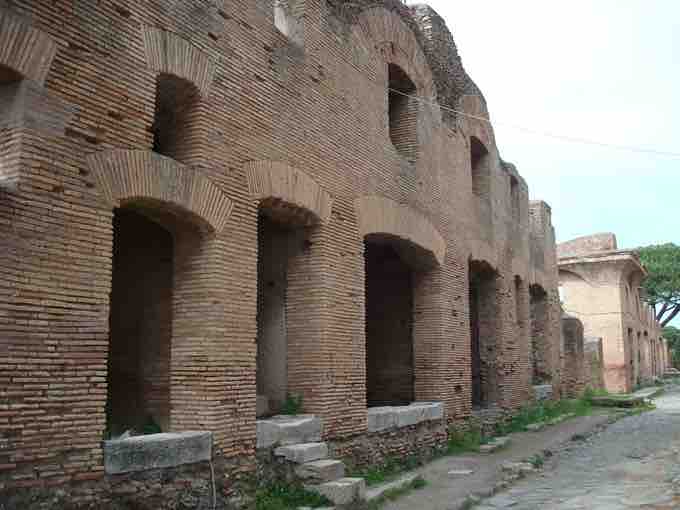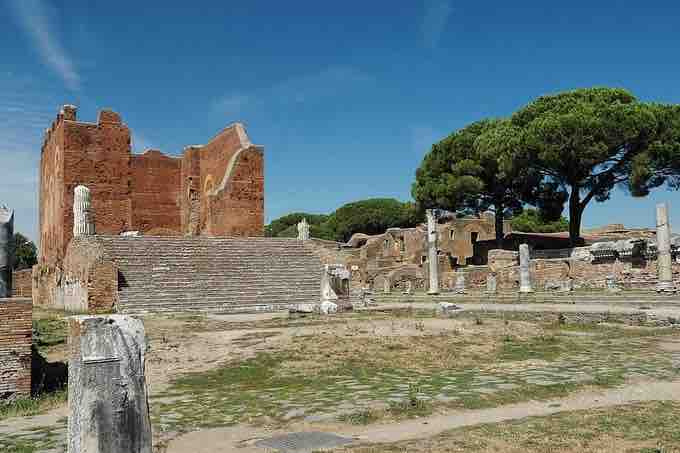Located at the mouth of the Tiber on the Tyrrhenian Sea, Ostia was the main port city of Rome. Today, due to the silting of the river, the remains of Ostia lay about 3 km from the sea. The city was first founded during the third century BCE, as one of Rome's earliest colonies. Its initial plan recalls a castru, or a military encampment, that was often used as a layout when establishing new cities or colonies. Today, Ostia Antica is noted for its impressive set of ruins. A majority of the city was hastily excavated and reconstructed under Mussolini for the 1942 World's Fair, which never occurred because of the start of World War II.
The ruins of Ostia are from the city's imperial period when it was at the height of its prosperity. Since Rome was settled inland, Ostia was always an important component to Rome, especially as the empire expanded and relied on its provinces for survival. Merchant vessels and large ships filled with grains, building materials, and other goods to sell in Rome docked at Ostia, The goods were transferred to barges and taken up river to Rome. Under the patronage of Tiberius, Ostia became much larger and began to grow into an even larger and busier port. Trajan enlarged a second harbor, known as Portus, just to the north of Ostia. Portus could handle a larger capacity of ships than Ostia, and this eventually diverted trade from Ostia's habors, causing the city's importance to diminish. At its height in the second and third centuries CE, Ostia reached 75,000 inhabitants.
Insulae
Ostia provides evidence of what a busy, typical Roman city would have looked like. The city is typical of a Roman city, including a large central forum, bath houses , temples, a theatre, barracks for firemen, and apartment buildings. The two central streets of the city, the cardo and decumanius ran north-south and east-west through the city, intersecting at the forum–the center of the city's civic and religious activities. Citizens of Ostia lived in apartment houses or insulae , which stood six or seven stories high. The insulae of Ostia demonstrate the cramped and noisy living style that would have been common, not only in Ostia but also in Rome. Shops, known as tabernae, occupied the ground level of insulae, while the upper stories housed apartments. Roman apartments varied in size from larger homes located on the lower floors with private dining and cooking areas, as well as private toilets to small cramped rooms with communal cooking areas and toilets on the upper floors.

Insulae at Ostia
Insulae, or apartment blocks, in the city of Ostia Antica.

Mosaics from the Baths of Neptune.
Mosaics from the Baths of Neptune, Ostia Antica. The mosaic shows the god Neptune in a sea-quadriga surrounded by creatures of the sea.
Religion
Excavations at Ostia reveal a variety of temples and meeting sites for cults and rituals. This reflects the relative religious diversity within the Roman Empire. Common features throughout the Empire include the Capitolium, the temple dedicated to Jupiter, Juno, and Minerva, in the forum at the center of the city . Across from the Capitolium in the forum stands a temple dedicated to Augustus and Roma. Close by is the Temple to Hercules, and throughout the city are temples dedicated to gods related to shipping and commerce, as well temples built by guilds, such as the ship builders or the rope makers, for their patron gods. On the city's outskirts, there is also a large sanctuary to the goddess Cybele or Magna Mater, attesting to her popularity in the city. The god Mithras was also popular among the Ostians and worshiped solely by men in the form of a mystery cult. Over 15 mithraea have been discovered in the city. These mithraea are nearly all built underground to replicate the cave central to the myths of Mithras.

The Capitolium at Ostia Antica
The Capitolium in the forum at Ostia Antica.
Ostia was also home to an early Christian church, as well as a Jewish Synagogue. The church takes the rough form of a basilica with a central nave decorated with two rows of columns and an aisle on one side and rooms on the other. The Ostia synagogue is considered to be the oldest in Europe and dates to the mid-first century CE, under the reign of Claudius.
Isola Sacra
The necropolis of the Isola Sacra was developed along the road between the cities of Ostia and Portus. When Trajan expanded Portus, he had a canal constructed between the harbor and the river Tiber that turned the area of the necropolis into an island. The Isola Sacra provides insight into plebeian art and funerary practices during the second and third centuries CE. The wealthier families of Ostia were able to build large, elaborate burial houses for their personal use,ƒ while the everyday shopkeepers and workers relied on their guilds to create communal funerary homes and see to the proper burial of each other's remains. These tombs are identified by scenes of daily life and images of the guild member's profession.